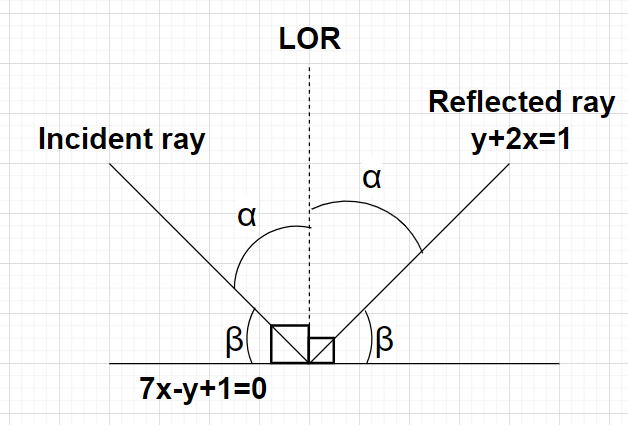Question
Question: A ray of light is incident along a line which meets another line \(7x - y + 1 = 0\), at the point (0...
A ray of light is incident along a line which meets another line 7x−y+1=0, at the point (0,1). The ray is then reflected from this point along the line y+2x=1. What is the equation of the line of incidence of the ray of light?
A. 41x−25y+25=0 B. 41x+25y−25=0 C. 41x+38y−38=0 D. 41x−38y+38=0

Solution
Hint: Here, we will proceed by using the law of reflection that the angle of incidence is always equal to the angle of reflection and then use the formula tanθ=1+m1m2m2−m1 to evaluate the slope of the incident ray of light.
Complete step-by-step answer:
Given, equation of the reflected ray of light is y+2x=1
Let m be the slope of the incident ray of light.
Let α be the angle of incidence of the incident ray of light as shown in the figure.
Therefore, the angle between the incident ray of light and the line 7x−y+1=0 will be equal to (900−α)=β (say).
Clearly, the perpendicular to the line 7x−y+1=0 is the line of reference (LOR).
According to laws of reflection, we know that the angle of incidence of the ray of light is equal to the angle of reflection of the ray of light. So, the angle of the reflection of the reflected ray of light y+2x=1 will also be equal to α as shown in figure.
Also, the angle between the reflected ray of light y+2x=1 and the line 7x−y+1=0 will also be equal to (900−α)=β.
Since, the angles made by the incident ray of light and the reflected ray of light with the line 7x−y+1=0 are same (i.e., (900−α)=β).
As we know that angle between two lines whose slopes are m1 and m2 is given by tanθ=1+m1m2m2−m1
Any general equation of line is given by y=mx+c ⇒mx−y+c=0 →(1) where m is the slope of the line and c is the y intercept of the line.
So, the angle between the incident ray of light whose slope is m and the line 7x−y+1=0 whose slope is 7 will be equal to the angle between the reflected ray of light y+2x=1 ⇒−2x−y+1=0 whose slope is -2 and the line 7x−y+1=0 whose slope is 7.
i.e., 1+7mm−7=1+(−2)(7)−2−7 ⇒1+7mm−7=1−14−9=−13−9 ⇒1+7mm−7=139
Either 1+7mm−7=139 ⇒13(m−7)=9(1+7m) ⇒13m−91=9+63m ⇒50m=−100 ⇒m=−2 or 1+7mm−7=−139 ⇒13(m−7)=−9(1+7m) ⇒13m−91=−9−63m ⇒76m=82 ⇒m=7682=3841
So, the slope of the incident ray of light is either -2 or 3841.
Equation of the incident ray of light can be written using equation (1) as mx−y+c=0
When m=-2, equation of the incident ray of light becomes −2x−y+c=0
When m=3841, equation of the incident ray of light becomes 3841x−y+c=0
Since, the incident ray of light meets the line 7x−y+1=0 at a point (0,1) which means this point will satisfy the equation of the incident ray of light.
For the equation of the incident ray of light as −2x−y+c=0,
⇒(−2×0)−1+c=0 ⇒c=1
Hence, the equation of the incident ray of light is −2x−y+1=0 which is not there in the options.
For the equation of the incident ray of light as 3841x−y+c=0,
⇒38(41×0)−1+c=0 ⇒c=1
Hence, the equation of the incident ray of light is 3841x−y+1=0 ⇒3841x−38y+38=0 ⇒41x−38y+38=0
Hence, option D is correct.
Note: In this particular problem, there are two equations of the incident ray of light which can be possible i.e., −2x−y+1=0 and 41x−38y+38=0 but here only 41x−38y+38=0 is considered because of the options given in the problem.
